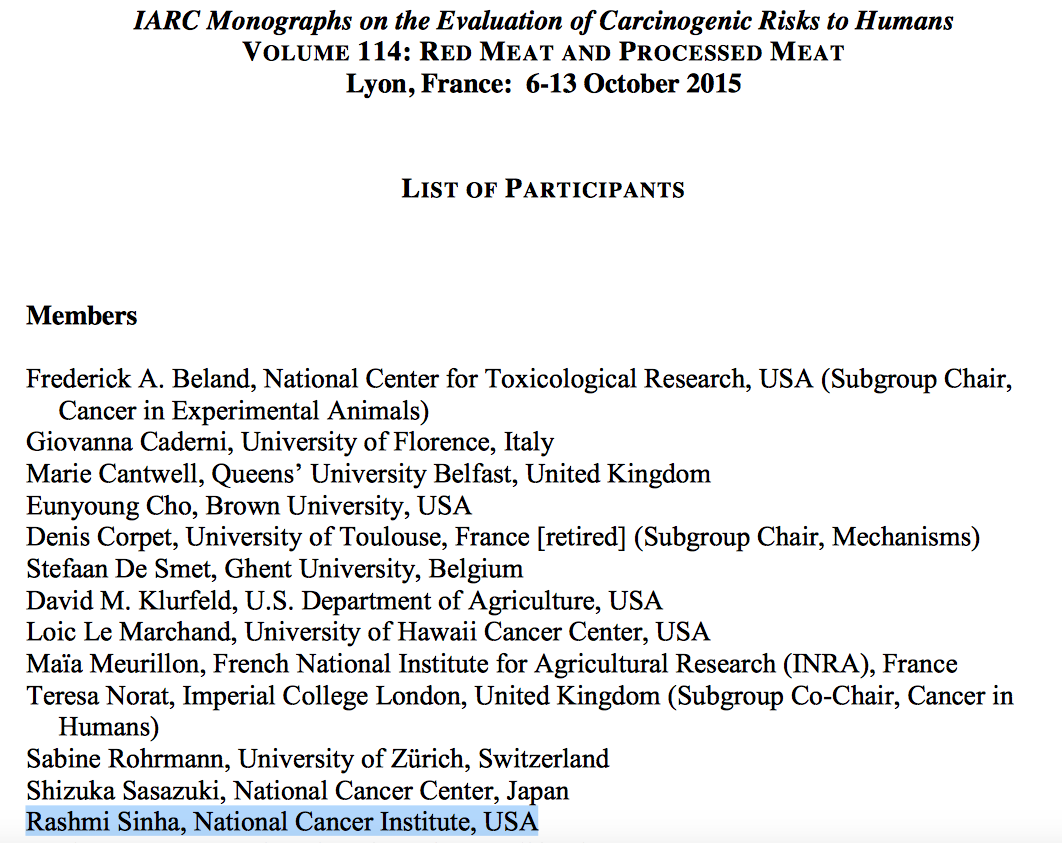I’ve been writing about National Cancer Institute’s meat-hating vegetarian Rashmi Sinha since 2000.
Here is the WHO media release. Note the WHO panel’s analysis is not yet published — so science by media release release.

Sinha was on the WHO panel along with, no doubt, many other meat anti-meat researcher-activists. Here’s a 2005 column I wrote about her for FOXnews.com. It references a 2000 column about her as well. She’s been attacking meat since at least 1994.

Press releases blamed for exaggerated health news
WEDNESDAY, Dec. 10, 2014 (HealthDay News) — Exaggerated news reports about health research often can be traced back to press releases issued by universities, a new British study suggests.
Improving the accuracy of these news releases could greatly reduce the amount of misleading health news, the researchers said in their Dec. 9 report in the BMJ.
The blame “lies mainly with the increasing culture of university competition and self-promotion, interacting with the increasing pressures on journalists to do more with less time,” Petroc Sumner and Chris Chambers, both of Cardiff University in Wales, wrote in a journal news release.
They analyzed 462 news releases on health-related research issued by 20 leading universities in the United Kingdom in 2011 and compared them to the studies they described and to 668 national news stories about the studies.
Compared to the actual studies, 40 percent of the releases contained exaggerated advice, one-third contained exaggerated causal claims, and 36 percent contained exaggerated inferences about how animal research applied to people.
If press releases exaggerated the research, it was more likely that news stories would do the same — 58 percent for advice, 81 percent for causal claims, and 86 percent for inference to humans, the researchers found. When press releases did not exaggerate, rates of exaggeration in news stories were 17 percent, 18 percent and 10 percent, respectively.
However, hyperbole in press releases did not increase the chances that the research would make the news.
Journalists and media outlets are often blamed for stories being sensationalized or alarmist, but these findings show that these faults “are already present in the text of the press releases produced by academics and their establishments,” the researchers said in a journal news release.
Reducing exaggeration in press releases could improve the accuracy of health news, with potential benefits for public health, the researchers concluded.
One approach would be to make academic researchers accountable for news releases about their work, Ben Goldacre, research fellow at the London School of Hygiene and Tropical Medicine, wrote in an accompanying journal editorial.
http://www.fox54.com/story/27594148/press-releases-blamed-for-exaggerated-health-news
OSHA also took on the passive smoking fraud and this is what came of it:
Reference Manual on Scientific Evidence: Third Edition
This sorta says it all
These limits generally are based on assessments of health risk and calculations of concentrations that are associated with what the regulators believe to be negligibly small risks. The calculations are made after first identifying the total dose of a chemical that is safe (poses a negligible risk) and then determining the concentration of that chemical in the medium of concern that should not be exceeded if exposed individuals (typically those at the high end of media contact) are not to incur a dose greater than the safe one.
So OSHA standards are what is the guideline for what is acceptable ”SAFE LEVELS”
OSHA SAFE LEVELS
All this is in a small sealed room 9×20 and must occur in ONE HOUR.
For Benzo[a]pyrene, 222,000 cigarettes.
“For Acetone, 118,000 cigarettes.
“Toluene would require 50,000 packs of simultaneously smoldering cigarettes.
Acetaldehyde or Hydrazine, more than 14,000 smokers would need to light up.
“For Hydroquinone, “only” 1250 cigarettes.
For arsenic 2 million 500,000 smokers at one time.
The same number of cigarettes required for the other so called chemicals in shs/ets will have the same outcomes.
So, OSHA finally makes a statement on shs/ets :
Field studies of environmental tobacco smoke indicate that under normal conditions, the components in tobacco smoke are diluted below existing Permissible Exposure Levels (PELS.) as referenced in the Air Contaminant Standard (29 CFR 1910.1000)…It would be very rare to find a workplace with so much smoking that any individual PEL would be exceeded.” -Letter From Greg Watchman, Acting Sec’y, OSHA.
Why are their any smoking bans at all they have absolutely no validity to the courts or to science!
The report has been released and it is as expected a real farce. There is in fact no real link between processed meats and bowel cancer.
My husband points out that many European countries use sausage as a main dish: Poland, Germany, Serbia, and Croatia is but a small selection of those countries. There has not been any statistics showing an increase in bowel cancer in those countries.
I say: never trust the words of a vegetarian.